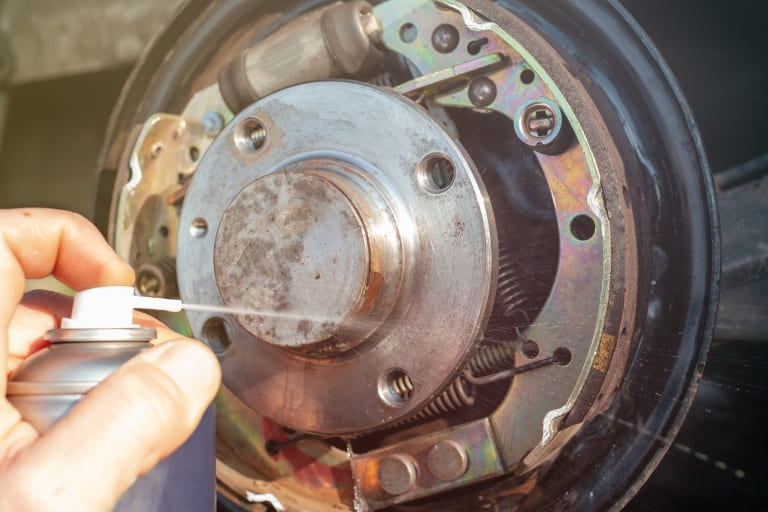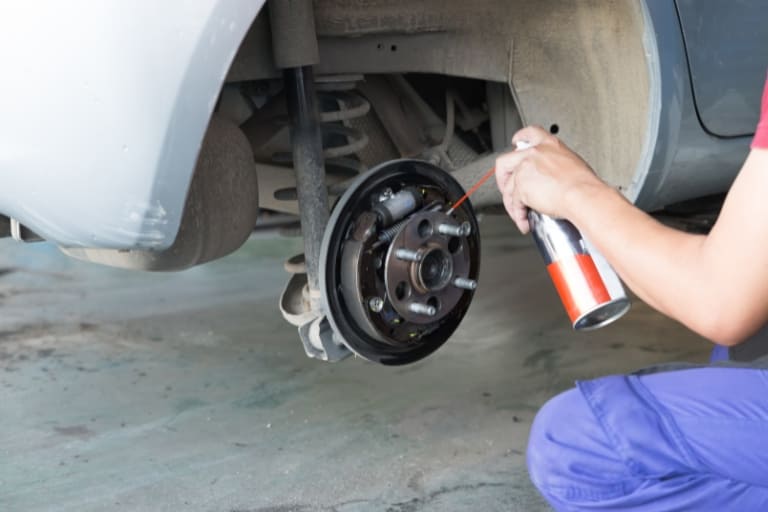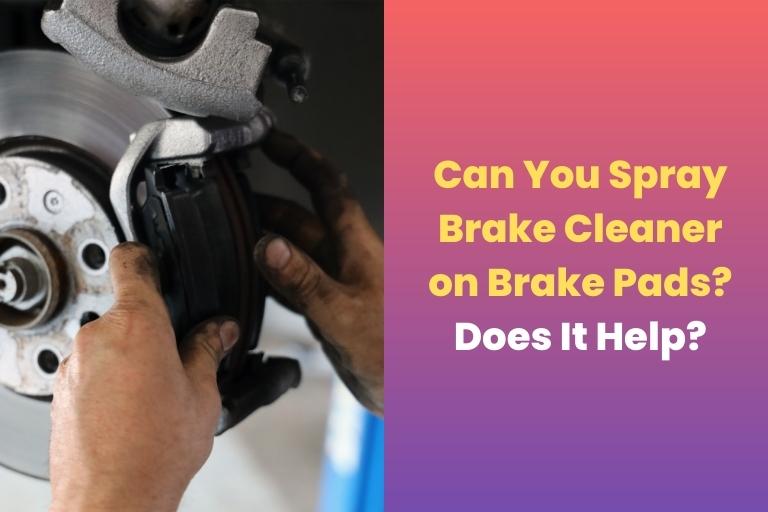Brake maintenance is crucial to keeping your vehicle safe and in excellent functioning order. However, there is frequently uncertainty over the usage of specific chemicals, such as brake cleaner, on various components of the braking system.
One often asked topic is whether brake cleaner may be safely used on brake pads. While some may claim it is helpful, others warn against it due to potential hazards and detrimental effects on brake performance.
In this article, we will examine both sides of the issue and provide some recommendations on the best techniques for maintaining your vehicle’s braking system in a balanced manner.
Contents
Can you spray brake cleaner on the brake pads?
Yes, you may use brake cleaner to clean your brake pads. This will help remove accumulated debris or dust over time and make the brake pad more effective.
What is brake cleaner for?

Brake cleaner is a type of solvent-based cleaner used to remove dirt, oil, grease, and other pollutants from braking systems. It is often used in automobiles, trucks, motorcycles, and other vehicles to clean brake rotors, calipers, drums, pads, and other braking components.
Brake cleaner is very effective in removing brake dust, which is a mixture of metal filings, carbon fibers, and other particles that can collect on brake components over time. If brake dust is not cleared on a regular basis, it can be corrosive and cause damage to braking components.
NOTE: It is always a good idea to examine your brake pads once a year or if you notice any symptoms. The braking system is not only important for the health of your car, but it also protects you and other road users and is necessary for road safety.
Thus, neglecting this may save you money in the short term but may harm you or other road users in the long run. It is so advised that you should follow the manufacturer’s instructions and keep your car in well maintained condition.”
Types of brake spray cleaners
There are several types of brake spray cleaners on the market. However, there are two kinds of brake cleaners:
- Chlorinated
- Non-chlorinated
Chlorinated
Chlorinated brake cleaners include a strong chlorinated solvent that is good at removing oil, grease, and other impurities from brake components. However, it is recognized to be more destructive to the environment and pose health hazards to users.
Non-chlorinated Brake Cleaner
This type of brake cleaner use a less hazardous solvent while eliminating impurities from brake components. It is regarded as a more secure alternative to chlorinated brake cleaners.
The other types of brake spray cleaners available on the market, include:
Low-VOC Brake Cleaner
Compared to other brake cleaners, low-VOC (Volatile Organic Compound) brake cleaners are meant to be ecologically benign and have fewer emissions.
High-Flashpoint Brake Cleaner
It has a greater flashpoint than other varieties. It is less likely to ignite or cause a fire. This is especially helpful when working with heated brake components.
How to safely use brake cleaner

When using brake cleaner, it is critical to observe the following safety precautions:
Work in a well-ventilated area
Brake cleaner includes strong solvents that can emit dangerous vapors when inhaled. It is critical to operating in a well-ventilated environment, such as the outdoors or a well-ventilated garage or workshop.
Use the appropriate amount
Use the amount of brake cleaning specified on the packaging. Excessive usage of the cleaner might result in excess runoff and waste of the substance.
Avoid spraying painted surfaces
Because brake cleaner can harm painted surfaces or other sensitive materials, avoid spraying it on anything other than the braking components.
Use with caution around open flames
Avoid using brake cleaner near open flames or hot surfaces: Brake cleaner is combustible. Therefore avoid using it near open flames or hot surfaces. Before using the cleaner, make sure the brake components are completely cold.
Proper disposal
Dispose of the brake cleaner in line with local rules. Do not dump the cleanser down the drain or throw it away.
Also, Check: Brake Shuddering After New Rotors and Pads
Things to keep in mind while spraying brake cleaner on brake pads
There are a few things to bear in mind while spraying brake cleaner on brake pads to guarantee that the operation is safe and effective:
Wear safety equipment
Always wear gloves, eye protection, and a respirator mask when using brake cleaner if necessary. This will protect you from any gases or particles emitted throughout the cleaning procedure.
Avoid spraying too close to the brake pad
Spraying the brake cleaner too close to the brake pad might cause the cleaner to seep into the pad and potentially harm it. Hold the spray nozzle a few inches away from the pad instead.
Allow the cleaner to evaporate
After spraying the brake cleaner, please wait for it to evaporate completely before reassembling the braking components. This ensures no residue is left on the pad or other braking components, which might impair their effectiveness.
Reusing old brake pads is not recommended
While brake cleaner can assist in removing certain pollutants from old brake pads, it cannot restore the pad’s full stopping capability. If your brake pads are old, replace them with fresh pads to guarantee maximum braking performance.
Also, Check: Are Brake Pads Interchangeable?
Follow the manufacturer’s instructions
Always follow the brake cleaner package’s recommendations and any instructions supplied by the brake pad manufacturer. This will assist in ensuring that you’re using the cleaner properly and effectively and that you’re not doing anything that might harm the brake pads or other braking components.
You May Also Like To Read: Why Wheel Won’t Spin After a Brake Change?
Frequency Asked Questions
Do brake pads need brake cleaner?
Yes. You may put brake cleaner on your brake pads. It is a safe and effective brake pad and shoe lining cleaning. A few squirts of brake cleaner eliminates oil and dirt that can harm brake pads and rotors. When new brake pads and shoes are installed, brake cleaner eliminates excess grease and oil.
Where not to spray brake cleaner?
Spraying brake cleaner on painted surfaces, plastic, or rubber parts can cause damage or discoloration. Because it is very flammable, it should not be used near open flames or hot surfaces. It should also not be sprayed directly into the eyes or consumed.
Related Articles, You May Like:
- Brake Pads Not Touching the Whole Disc
- Does the Emergency Brake Lock All Wheels?
- Can You Use Front Brake Pads on The Rear?
- Why Does My Car Shake After Changing the Brake Pads?
- How Long Do Brake Pads Last: Brake Pad Lifespan Explained
- How to Install Anti-Rattle Clips on Brake Pads
- How Long Can You Drive Without Brake Pads?
- How Long Do Brake Pads Last: Brake Pad Lifespan Explained
- How to Fix New Ceramic Brake Pads Making Grinding Noise
- Ceramic vs. Semi-Metallic Brake Pads: Which is Better?
- Ceramic vs OEM brake pads
- Why Are My Brakes Grinding After New Pads And Rotors
- Ceramic vs Organic Brake Pads
- Ceramic vs Carbon Fiber Brake Pads
Conclusion
To summarize, a brake cleaner is an effective instrument for cleaning and servicing brakes, but it should be handled with caution and attention. It is critical to follow the directions on the container and avoid spraying it on painted, plastic, or rubber parts since this might cause damage.
Furthermore, because it is very flammable, it should not be used near open flames or hot surfaces. Overall, while brake cleaner may be a useful tool for cleaning and maintaining brakes, it is critical to use it cautiously and appropriately to avoid accidents or damage.
References:
